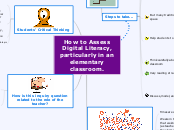How to Assess Digital Literacy, particularly in an elementary classroom.

How does this inquiry link to Critical Digital Literacy?
Times are changing
We are in the technological age and now that we know how to and are taught how to (as teachers) incorporate technology into the classroom a little bit....
it is important that the use of technology is not just used to motivate the students' participation...
...but to educate them on the new advances in technological education.

Students' Critical Thinking
A student's critical thinking, with regards to digital literacy, involves a student thinking about how they are perceived online.
As well, a students' critical digital literacy considers exactly how that which they view and take part in online affects them, their lifestyles, their perspectives on the world, and the world's perspective on them.
Critical digital literacy takes responsibility, ability and maturity, which come from learning and thinking critically about the world around us.
Subtopic

How is this inquiry question related to the role of the teacher?
Teachers need to know the learning level that each of their students are at in any subject. Teachers learn this through evaluation, observation and assessment.
When teachers are aware of the learning level their student's are at, with regards to digital literacy, they can more effectively, efficiently, and equitably assess and evaluate.

Steps to take...
Emphasize the importance of a digital reading mindset
online articles
books online
e-mails
Help students to manage digital distractions while reading and e-reading
downloading the online documents and then disconnecting the internet so as not not be distracted by... the internet, online advertisement and other online activities
social media
online advertisements
other online sites
online articles
online information
Don’t assume traditional reading skills transfer to digital reading
phonemic awareness
fluency
vocabulary
comprehension
But many traditional reading practices are still useful in a digital space
reading from life to right
scanning (for information)
Help students to develop reflective reading practices
linking information in the text with a conclusion
examining the effect their personal lives have on the meanings they create
arranging information in order to arrive at a desired conclusion
analyze how their conclusions are influenced by extra-textual factors
Think carefully about how you’ll employ digital reading in and out of the classroom
online articles
power points/google slideshows
Vary reading strategies according to reading purposes and environments
Discuss, model, and reinforce digital reading skills explicitly
Compare how Non-fiction writing and e-reading sometimes look the same and use the same elements
topics
subtopics
glossary
search bars
pictures with sub text
